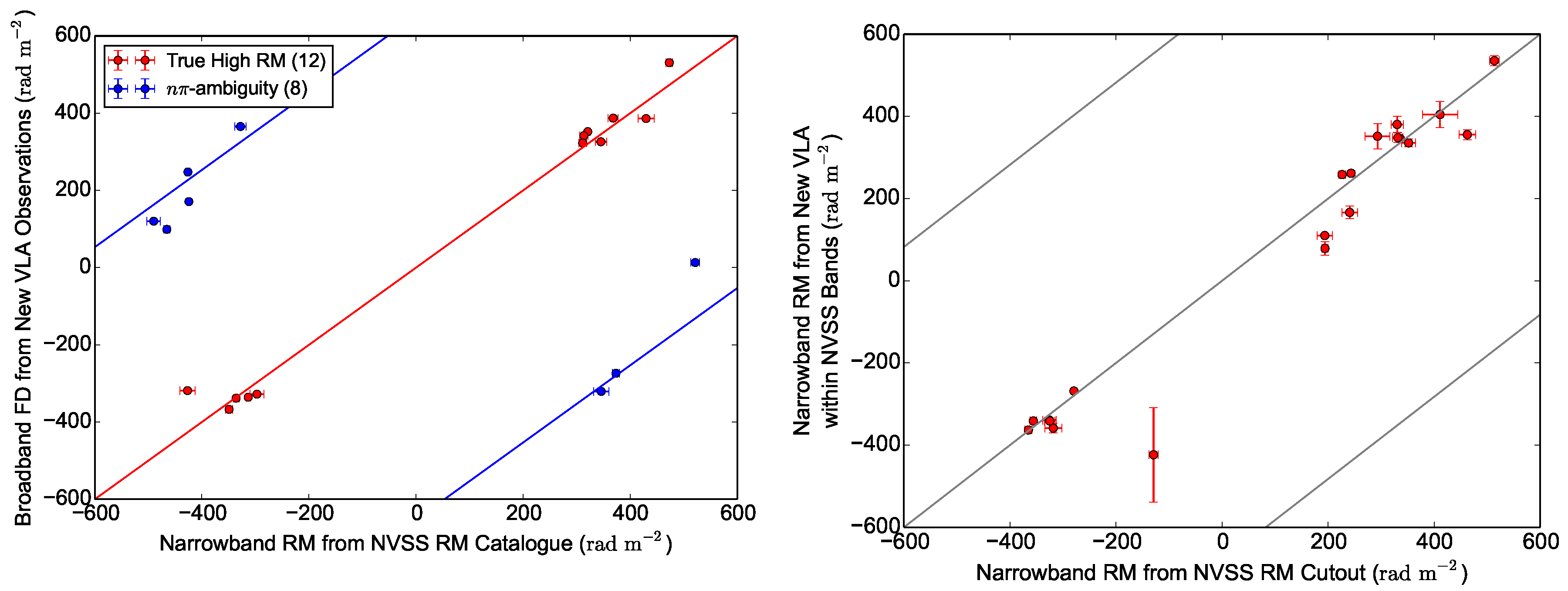Radio Polarisation Study of High Rotation Measure AGNs
Abstract
:1. Introduction
2. Observations and Data Reduction
2.1. Source Selection
2.2. Observational Setup and Data Reduction
3. Results
3.1. RM Synthesis
3.2. Direct Comparison with NVSS RM Catalogue
3.3. QU-Fitting
4. Discussion
4.1. -Ambiguity in the NVSS RM Catalogue
4.2. Possible RM Variabilities
4.3. QU-Fitting as Probe of Vicinities of AGN Jets
5. Summary
Acknowledgments
Author Contributions
Conflicts of Interest
References
- Beck, R. Magnetic fields in spiral galaxies. Astron. Astrophys. Rev. 2016, 24, 4. [Google Scholar] [CrossRef]
- Brentjens, M.A.; de Bruyn, A.G. Faraday rotation measure synthesis. Astron. Astrophys. 2005, 441, 1217–1228. [Google Scholar] [CrossRef]
- Taylor, A.R.; Stil, J.M.; Sunstrum, C. A Rotation Measure Image of the Sky. Astrophys. J. 2009, 702, 1230. [Google Scholar] [CrossRef]
- Harvey-Smith, L.; Madsen, G.J.; Gaensler, B.M. Magnetic Fields in Large-diameter H II Regions Revealed by the Faraday Rotation of Compact Extragalactic Radio Sources. Astrophys. J. 2011, 736, 83. [Google Scholar] [CrossRef]
- Purcell, C.R.; Gaensler, B.M.; Sun, X.H.; Carretti, E.; Bernardi, G.; Haverkorn, M.; Kesteven, M.J.; Poppi, S.; Schnitzeler, D.H.F.M.; Staveley-Smith, L. A Radio-Polarisation and Rotation Measure Study of the Gum Nebula and Its Environment. Astrophys. J. 2015, 804, 22. [Google Scholar] [CrossRef]
- Terral, P.; Ferrière, K. Constraints from Faraday rotation on the magnetic field structure in the Galactic halo. Astron. Astrophys. 2017, 600, A29–A51. [Google Scholar] [CrossRef]
- Condon, J.J.; Cotton, W.D.; Greisen, E.W.; Yin, Q.F.; Perley, R.A.; Taylor, G.B.; Broderick, J.J. The NRAO VLA Sky Survey. Astron. J. 1998, 115, 1693. [Google Scholar] [CrossRef]
- McMullin, J.P.; Waters, B.; Schiebel, D.; Young, W.; Golap, K. CASA Architecture and Applications. In Astronomical Data Analysis Software and Systems XVI ASP Conference Series, Proceedings of 16th annual conference on Astronomical Data Analysis Software and Systems (ADASS XVI), Tucson, AZ, USA, 15–18 October 2006; Shaw, R.A., Hill, F., Bell, D.J., Eds.; Publications of the Astronomical Society of the Pacific: San Francisco, CA, USA, 2007; Volume 376, p. 127. [Google Scholar]
- Heald, G.; Braun, R.; Edmonds, R. The Westerbork SINGS survey. II Polarization, Faraday rotation, and magnetic fields. Astron. Astrophys. 2009, 503, 409–435. [Google Scholar] [CrossRef]
- Mao, S.A.; Gaensler, B.M.; Haverkorn, M.; Zweibel, E.G.; Madsen, G.J.; McClure-Griffiths, N.M.; Shukurov, A.; Kronberg, P.P. A Survey of Extragalactic Faraday Rotation at High Galactic Latitude: The Vertical Magnetic Field of the Milky Way Toward the Galactic Poles. Astrophys. J. 2010, 714, 1170. [Google Scholar] [CrossRef]
- O’Sullivan, S.P.; Brown, S.; Robishaw, T.; Schnitzeler, D.H.F.M.; McClure-Griffiths, N.M.; Feain, I.J.; Taylor, A.R.; Gaensler, B.M.; Landecker, T.L.; Harvey-Smith, L.; et al. Complex Faraday depth structure of active galactic nuclei as revealed by broad-band radio polarimetry. Mon. Not. R. Astron. Soc. 2012, 421, 3300–3315. [Google Scholar] [CrossRef]
- Anderson, C.S.; Gaensler, B.M.; Feain, I.J. A Study of Broadband Faraday Rotation and Polarization Behavior over 1.3–10 GHz in 36 Discrete Radio Sources. Astrophys. J. 2016, 825, 59. [Google Scholar] [CrossRef]
- Burn, B.J. On the depolarization of discrete radio sources by Faraday dispersion. Mon. Not. R. Astron. Soc. 1966, 133, 67–83. [Google Scholar] [CrossRef]
- Sokoloff, D.D.; Bykov, A.A.; Shukurov, A.; Berkhuijsen, E.M.; Beck, R.; Poezd, A.D. Depolarization and Faraday effects in galaxies. Mon. Not. R. Astron. Soc. 1998, 299, 189–206. [Google Scholar] [CrossRef]
- Oppermann, N.; Junklewitz, H.; Robbers, G.; Bell, M.R.; Enßlin, T.A.; Bonafede, A.; Braun, R.; Brown, J.C.; Clarke, T.E.; Feain, I.J.; et al. An improved map of the Galactic Faraday sky. Astron. Astrophys. 2012, 542, A93–A106. [Google Scholar] [CrossRef]
- Jagannathan, P.; Bhatnagar, S.; Rau, U.; Taylor, A.R. Direction-dependent Corrections in Polarimetric Radio Imaging. I. Characterizing the Effects of the Primary Beam on Full-Stokes Imaging. Astron. J. 2017, 154, 56. [Google Scholar] [CrossRef]
- Haverkorn, M.; Brown, J.C.; Gaensler, B.M.; McClure-Griffiths, N.M. The Outer Scale of Turbulence in the Magnetoionized Galactic Interstellar Medium. Astrophys. J. 2008, 680, 362. [Google Scholar] [CrossRef]
- Laing, R.A. The sidedness of jets and depolarization in powerful extragalactic radio sources. Nature 1988, 331, 149–151. [Google Scholar] [CrossRef]
- Garrington, S.T.; Leahy, J.P.; Conway, R.G.; Laing, R.A. A systematic asymmetry in the polarization properties of double radio sources with one jet. Nature 1988, 331, 147–149. [Google Scholar] [CrossRef]
| 1 | Available on http://www.github.com/mrbell/pyrmsynth. |


© 2017 by the authors. Licensee MDPI, Basel, Switzerland. This article is an open access article distributed under the terms and conditions of the Creative Commons Attribution (CC BY) license (http://creativecommons.org/licenses/by/4.0/).
Share and Cite
Ma, Y.K.; Mao, S.A.; Basu, A.; Heiles, C.; West, J. Radio Polarisation Study of High Rotation Measure AGNs. Galaxies 2017, 5, 66. https://doi.org/10.3390/galaxies5040066
Ma YK, Mao SA, Basu A, Heiles C, West J. Radio Polarisation Study of High Rotation Measure AGNs. Galaxies. 2017; 5(4):66. https://doi.org/10.3390/galaxies5040066
Chicago/Turabian StyleMa, Yik Ki, Sui Ann Mao, Aritra Basu, Carl Heiles, and Jennifer West. 2017. "Radio Polarisation Study of High Rotation Measure AGNs" Galaxies 5, no. 4: 66. https://doi.org/10.3390/galaxies5040066






